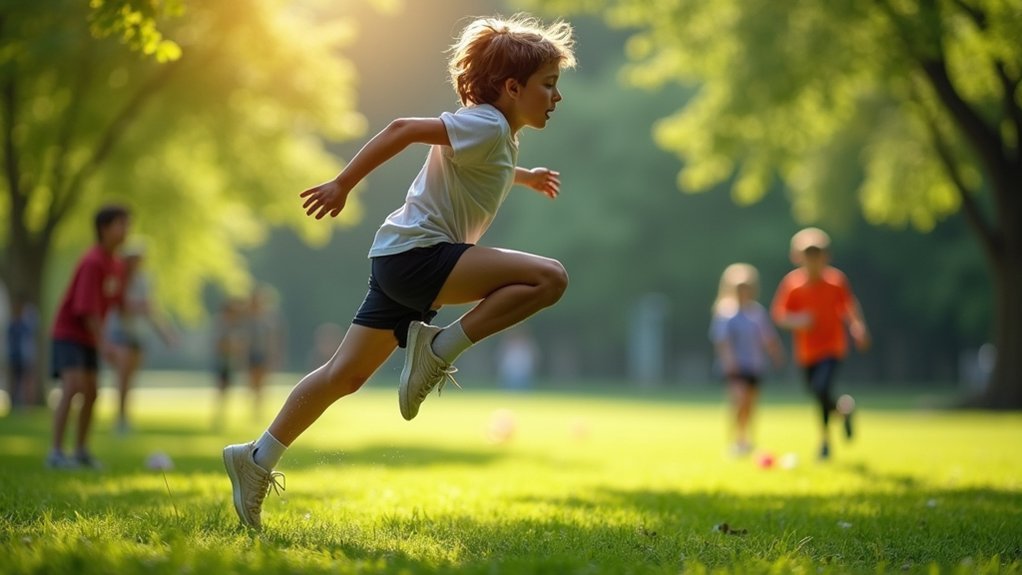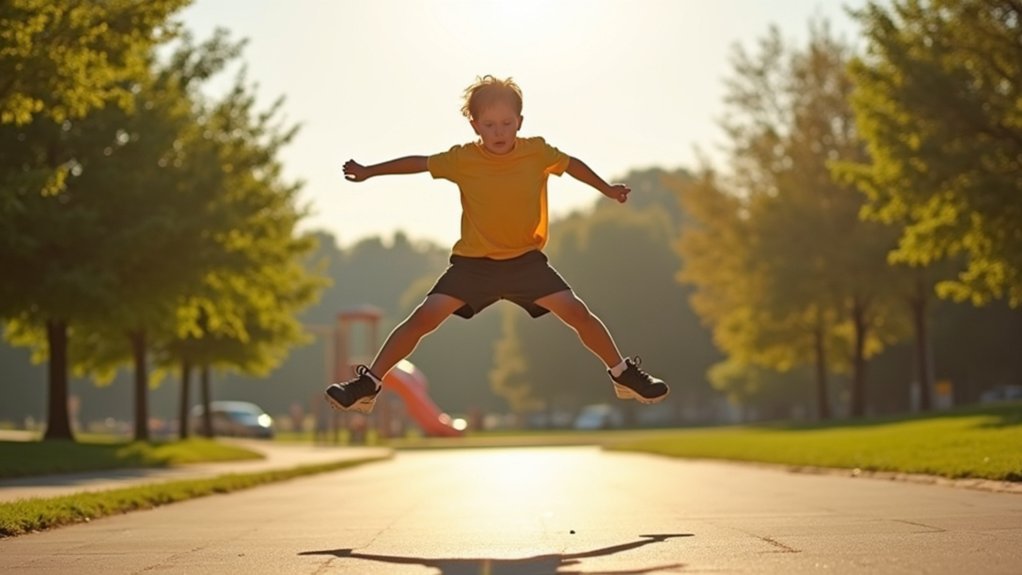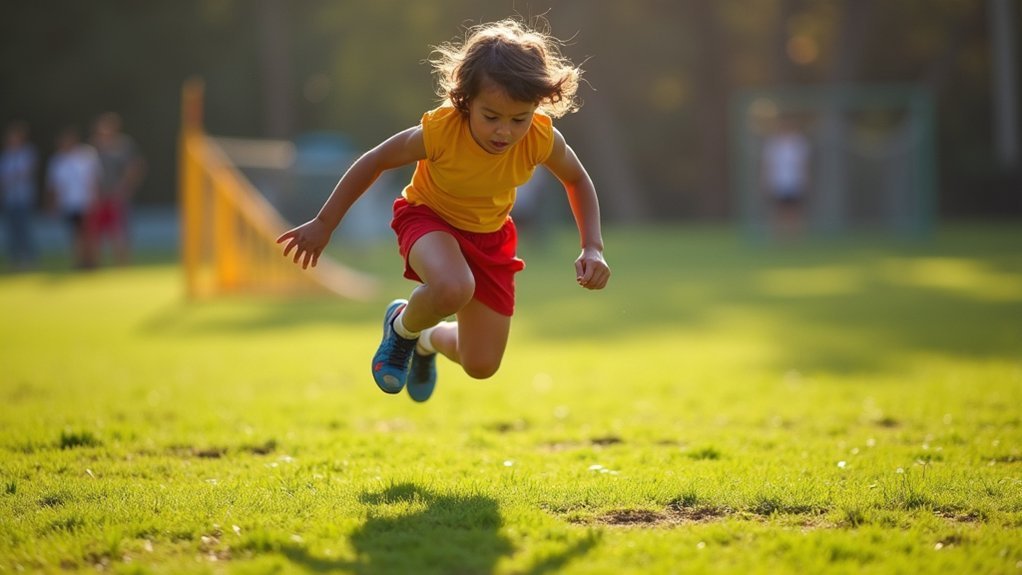Jumping develops your balance through five key mechanisms: it activates your neuromuscular system through stretch-shortening cycles, strengthens bones and muscles that support stability, enhances proprioception through landing challenges, improves coordination via rebounding activities, and boosts cognitive processing related to spatial awareness. Even five jumps daily can trigger improvements when done consistently. Regular jump training challenges your vestibular system and creates new neural pathways that translate to better stability in everyday movements.
The Neuromuscular Connection: How Jumping Activates Your Balance System

When you leap into the air, your body engages far more than just the obvious muscles needed for propulsion. Your neuromuscular system springs into action through stretch-shortening cycles that rapidly lengthen and shorten your muscle-tendon units, particularly in large muscle groups like your quadriceps.
These dynamic jump-landing tasks challenge your postural control systems, whether you’re performing unilateral or bilateral jumps across different directions and surfaces.
As you land, your somatosensory system processes essential input about your body’s position in space, while simultaneously coordinating your agonist and antagonist muscles. These types of differential training approaches can significantly improve balance performance in athletes like volleyball players.
The repetitive nature of jump training refines your body’s ability to make quick postural corrections, enhancing both static and dynamic stability.
This neuromuscular activation directly translates to improved balance performance in everyday movements and athletic tasks.
Stronger Bones and Muscles Lead to Better Stability
The neuromuscular benefits of jumping directly enhance your skeletal strength, creating a foundation for improved balance. When you perform just 10-20 jumps daily, you’ll notably increase bone mineral density in your femoral neck and lumbar spine—crucial areas for stability and mobility.
These high-impact movements don’t need to be excessive; even five jumps can stimulate bone strength improvements when done consistently. Your body responds to jumping by strengthening the muscles surrounding your hips and knees, which provides better joint support and reduces fall risk.
The targeted effects are most pronounced in load-bearing areas, where mechanical stress triggers localized bone formation. Research shows that jumping exercises specifically improve bone density in the femoral neck region, which is a common site for osteoporotic fractures.
Proprioception Power: Why Landing Improves Spatial Awareness

Landing from jumps dramatically enhances your proprioception—the internal GPS system that helps your body sense its position in space. Each time you land, specialized sensors in your muscles, tendons, and joints send critical feedback to your brain about how your body is positioned.
This repeated practice strengthens your body’s ability to make split-second adjustments without visual cues. When you land on various surfaces, you’re training proprioceptors to detect environmental changes and respond appropriately. This training helps maintain your center of gravity over your base of support, which is fundamental to balance control. This translates to improved balance in daily activities and sports performance.
You’ll develop better kinesthetic awareness as you practice, allowing more precise movements and reducing injury risk. Your body learns to stabilize quickly, enhancing your coordination and agility.
For older adults, this proprioceptive training is particularly valuable for preventing falls and maintaining independence.
Rebounding Your Way to Better Coordination
Rebounding activities take your balance training to new heights by creating a dynamic environment where your body must constantly adapt.
Each bounce activates proprioceptors in your joints while stimulating your vestibular system, refining your spatial awareness and equilibrium.
The unstable surface forces your deep core muscles, including your pelvic floor and transverse abdominis, to engage continuously.
This strengthens the neuromuscular connections responsible for maintaining stability during everyday movements.
You’ll notice improvements in reaction time and movement precision as your body learns to make micro-adjustments during directional changes.
The varied bounce patterns enhance bilateral coordination and reduce postural sway by strengthening ankle and hip stabilizers.
Regular rebounding mimics daily activities like maneuvering curbs or avoiding obstacles, effectively training those multi-directional reflexes you need for real-world balance challenges.
Research has shown that rebounding can significantly improve coordination as it enhances proprioception skills through consistent engagement of the vestibular system.
Beyond Physical Benefits: How Jumping Enhances Cognitive Balance Skills

Jumping exercises elevate more than just your physical capabilities—they fundamentally reshape your brain’s cognitive architecture.
When you engage in activities like rope skipping or trampolining, you’re simultaneously training your selective attention and inhibitory control, two critical components of cognitive function. Research shows that children participating in structured jump rope programs demonstrated significant improvement in inhibitory control as measured by the Stroop test.
Your brain’s prefrontal cortex and cerebellum activate during coordinated jumping, creating neural pathways that enhance your ability to filter distractions and focus on relevant stimuli. This explains why children who participate in structured jumping programs demonstrate improved performance on attention tests and cognitive flexibility tasks.
The rhythmic timing and split-second decision-making required during jumping activities strengthen the neural connections between your motor and cognitive systems, ultimately boosting your executive functions, including planning and working memory—skills that transfer directly to classroom and everyday performance.
Frequently Asked Questions
How Long Until I Notice Balance Improvements From Jumping Exercises?
You’ll likely notice balance improvements from jumping exercises within 6-8 weeks if you’re training consistently. Aim for three sessions weekly for ideal results, though individual progress varies based on your intensity and frequency.
Can People With Joint Problems Safely Incorporate Jumping Exercises?
Yes, you can safely incorporate jumping with joint problems by using mini-trampolines, water exercises, or modified low-impact movements. Start gradually, get medical clearance first, and stop immediately if you experience pain during activities.
Are Trampoline Exercises as Effective as Floor-Based Jumping?
Trampoline exercises can be as effective as floor-based jumping for improving balance. You’ll get comparable balance benefits from both, but trampolines offer lower impact on your joints while providing similar proprioceptive challenges.
How Many Jumping Sessions per Week Are Optimal for Balance?
You’ll achieve ideal balance improvements with 2-3 jumping sessions weekly. This frequency provides enough stimulus for neuromuscular adaptations while allowing sufficient recovery. Begin with 1-2 sessions if you’re a novice, then gradually increase.
Do Jumping Benefits Transfer to Sports Requiring Rotational Balance?
Yes, jumping benefits transfer directly to rotational sports. You’ll develop stronger core stability, enhanced proprioception, and improved neuromuscular coordination – all essential for maintaining balance during rotational movements in basketball, tennis, or golf.
In Summary
By embracing jumping exercises, you’re not just having fun—you’re rewiring your balance system from the ground up. You’ll build stronger muscles and bones, sharpen your proprioceptive awareness, and improve coordination with each landing. Even your cognitive functions benefit as you navigate mid-air adjustments. Make jumping part of your routine, and you’ll notice steadier footing in everything you do.





Leave a Reply